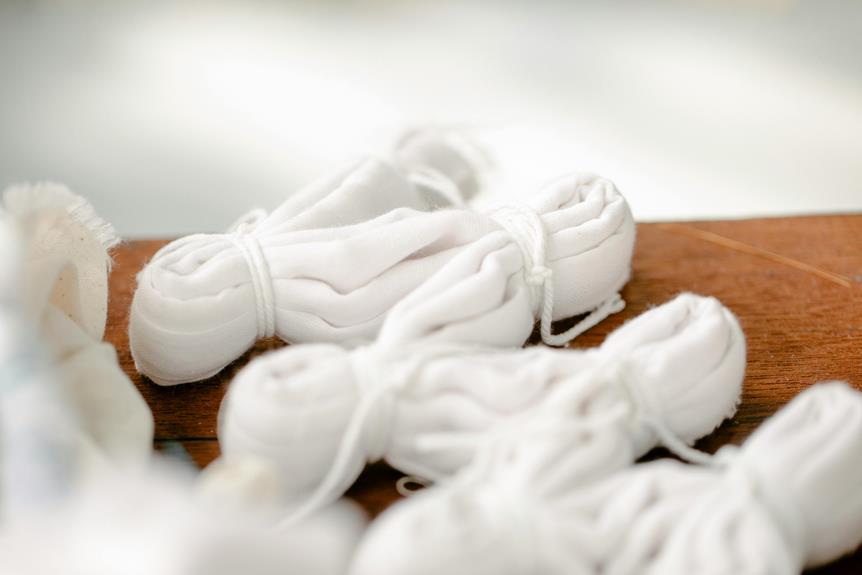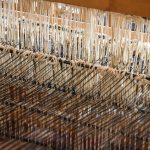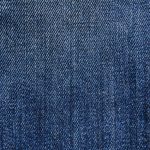When you're ready to sew with sateen fabric, understanding its unique properties is crucial for achieving the best results. You'll notice it has a slippery texture that can easily lead to mistakes if you're not careful. Start by pre-washing your fabric to avoid surprises later, and make sure to choose the right needle and thread. But that's just the beginning; mastering cutting and stitching techniques will further elevate your project. What strategies will you consider to ensure a smooth sewing experience?
Table of Contents
Understanding Sateen Fabric
Sateen fabric, often chosen for its soft sheen and smooth texture, is a cotton material that's woven with a satin weave to create a luxurious feel. This fabric's unique construction gives it a glossy surface on one side, while the other side remains matte. You'll appreciate its drape and weight, making it ideal for garments like dresses, blouses, and even home decor items such as curtains.
When working with sateen, you'll notice it can be a bit slippery. This characteristic means you should take care when cutting and pinning your fabric to prevent any shifting. It's essential to use sharp scissors and a rotary cutter for precise cuts. Additionally, the fabric tends to fray, so consider using pinking shears or an overlock stitch to finish your edges.
Ironing sateen can also be tricky; it's best to use a low heat setting and press from the reverse side to avoid any shine on the surface.
With the right approach, you can create stunning projects that showcase the elegance of sateen fabric, allowing your creativity to shine through in every stitch.
Choosing the Right Needle
When you're sewing with sateen fabric, choosing the right needle is crucial for a smooth finish.
You'll want to consider different needle types that work best with this material, as well as how to match your thread for optimal results.
Let's explore these important points to ensure your project turns out beautifully.
Needle Types Overview
Choosing the right needle is crucial for achieving smooth stitches and preventing damage to your sateen fabric. When working with this delicate material, you'll want to opt for a needle that suits its specific needs.
For most sateen projects, a universal needle in the size 80/12 is a great choice. This size strikes a balance between being fine enough to navigate the fabric's smooth surface while still providing enough strength to pierce through without snagging.
If you're sewing heavier weight sateen, such as a more structured dress or home décor item, consider using a size 90/14 needle. This larger needle can handle the thickness without compromising the integrity of the fabric.
For intricate work or detailed patterns, a sharp needle is ideal, as it provides precision and clean edges.
Avoid using a ballpoint needle, as its rounded tip may cause unwanted holes or distortions in your fabric.
Remember to replace your needle regularly, as a dull needle can lead to skipped stitches and fabric damage.
With the right needle, you'll be well on your way to creating beautiful projects with your sateen fabric!
Thread Compatibility Tips
Selecting the right thread is just as important as picking the appropriate needle to ensure your sateen projects turn out beautifully. The combination of thread and needle can significantly affect the quality of your seams and the overall appearance of your finished piece.
Here are some tips to help you choose the right needle for your sateen fabric:
- Universal Needles: Generally, a universal needle in size 70/10 or 80/12 works well for most sateen projects, providing a good balance between penetration and stitch formation.
- Microtex Needles: If you're working with finer sateen, consider using a Microtex needle. Its sharp point can easily pierce the fabric, resulting in clean, precise stitches without snagging.
Remember to always use a thread that matches your needle type. Polyester thread is often recommended for its strength and flexibility, making it a perfect match for the luxurious feel of sateen.
Happy sewing!
Selecting Suitable Thread
To achieve the best results with sateen fabric, opt for a thread that complements its unique sheen and drape. You'll want to choose a thread made from polyester or a cotton-poly blend since these materials offer strength and flexibility. They also match the fabric's smooth finish and won't detract from its lustrous appearance.
When selecting the thread weight, consider using a medium-weight thread, like a 40-weight. This weight provides enough strength for seams without being too bulky, which is crucial for maintaining the elegant look of sateen. Always test your thread on a scrap piece of the fabric before you begin your project. This helps ensure that the thread works well with your sewing machine and that the color matches perfectly.
For delicate seams or hems, you might opt for a finer thread, but keep in mind that this could compromise strength. Lastly, match your thread color closely to your fabric to create seamless, professional-looking results. If you're working with a patterned sateen, consider using a neutral color that blends well with all shades in the fabric. Getting your thread selection right is essential for achieving a polished finish.
Preparing Your Fabric
Once you've got your thread sorted, it's time to prepare your sateen fabric for sewing. Proper preparation will help you achieve the best results and make your sewing experience smoother.
Start by washing your fabric according to the care instructions, as this will pre-shrink it and remove any finishing chemicals. After washing, press it with an iron on a low setting to eliminate any wrinkles.
Here are a few key steps to keep in mind while preparing your fabric:
- Check for flaws: Inspect your fabric for any defects, such as snags or discoloration, before you start cutting or sewing.
- Stabilize the fabric: Use a fabric stabilizer if needed, especially for stretchy or slippery sections. This will help maintain the shape and prevent distortion during sewing.
Once your fabric is ready, you'll be set for the next steps in your sewing project. Proper preparation makes all the difference, so take your time with these initial steps!
Cutting Techniques for Sateen
When cutting sateen fabric, it's crucial to use sharp tools and take your time to ensure clean edges and accurate patterns.
Start by laying your fabric flat on a cutting surface. Use a rotary cutter or sharp scissors, as they'll help prevent fraying and ensure smooth cuts. If you're using scissors, make long, even cuts instead of snipping.
Next, consider the grain of the fabric. Always align your pattern pieces with the grainline indicated on the pattern. This helps maintain the fabric's drape and prevents twisting after sewing.
Pin the pattern pieces securely but don't overdo it—too many pins can distort the fabric.
Also, it's a good idea to use weights instead of pins when cutting. Weights keep your fabric flat and minimize the risk of shifting.
If you need to cut multiple layers, ensure they're aligned perfectly to avoid uneven edges.
Stitching Methods and Tips
After cutting your sateen fabric with precision, it's time to focus on the best stitching methods to ensure a polished finish. Sateen has a smooth, shiny surface that can be tricky to work with, but with the right techniques, you'll achieve professional results.
First, use a universal needle size 80/12 or 90/14 to avoid snagging. Sateen can slip, so consider using a walking foot to maintain even feeding. When it comes to stitching, a straight stitch is your best bet—set your machine to a shorter stitch length for durability.
Here are some tips to keep in mind:
- Use a thread that matches the sheen: Polyester or cotton-wrapped polyester threads work well with sateen.
- Test on scraps: Always sew a test sample to adjust tension and stitch length before working on your main project.
With these methods, you'll handle sateen fabric like a pro, creating garments that aren't only beautiful but also long-lasting.
Happy sewing!
Caring for Sateen Garments
Caring for sateen garments requires attention to detail to maintain their luxurious sheen and smooth texture.
Start by checking the care label; most sateen fabrics are best washed in cold water on a gentle cycle. Avoid using bleach, as it can damage the fibers and dull the finish. Instead, opt for a mild detergent to keep your fabric looking vibrant.
When it's time to dry your garments, hang them to air dry or use a low-heat setting in the dryer. High heat can shrink the fabric and cause it to lose its smoothness.
If you need to iron your sateen, do so while it's slightly damp and on the reverse side to prevent any shiny marks.
For stains, act quickly. Blot the stain with a clean cloth and a mild detergent solution, but don't rub, as this can spread the stain or damage the fabric.
Frequently Asked Questions
Can I Use a Regular Sewing Machine for Sateen Fabric?
Yes, you can use a regular sewing machine for sateen fabric. Just make sure you have the right needle and thread. Adjust your tension and stitch settings to avoid puckering while sewing. Happy sewing!
Is Sateen Fabric Suitable for Beginner Sewists?
Yes, sateen fabric's smooth texture and weight make it suitable for beginner sewists. You'll find it easier to handle and sew, helping you build confidence while creating beautiful projects without feeling overwhelmed.
How Does Sateen Fabric Compare to Cotton?
Sateen fabric feels smoother and shinier than cotton, giving your projects a luxurious touch. While cotton's breathable and versatile, sateen's weight and drape can elevate your designs, making them perfect for special occasions or elegant garments.
Can I Iron Sateen Fabric Without Damaging It?
Yes, you can iron sateen fabric without damaging it, but you should use a low to medium heat setting. Always test a small area first and consider using a pressing cloth for extra protection.
What Patterns Work Best With Sateen Fabric?
When choosing patterns, you'll want to consider bold prints and flowing designs that complement sateen's sheen. Floral, geometric, and abstract patterns work well, enhancing the fabric's luxurious look while adding visual interest to your project.
- Where to Buy Sherpa Suede Fabric - July 12, 2025
- How to Draw or Illustrate the Texture of Suede Fabric - July 12, 2025
- What Is Baseball Suede Leather Fabric? - July 12, 2025







